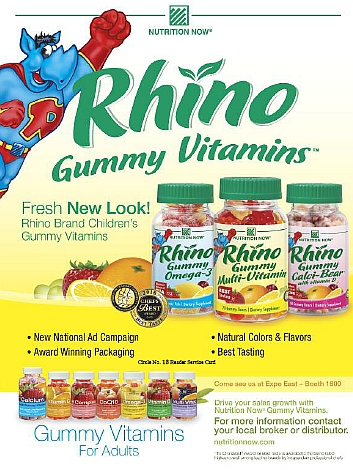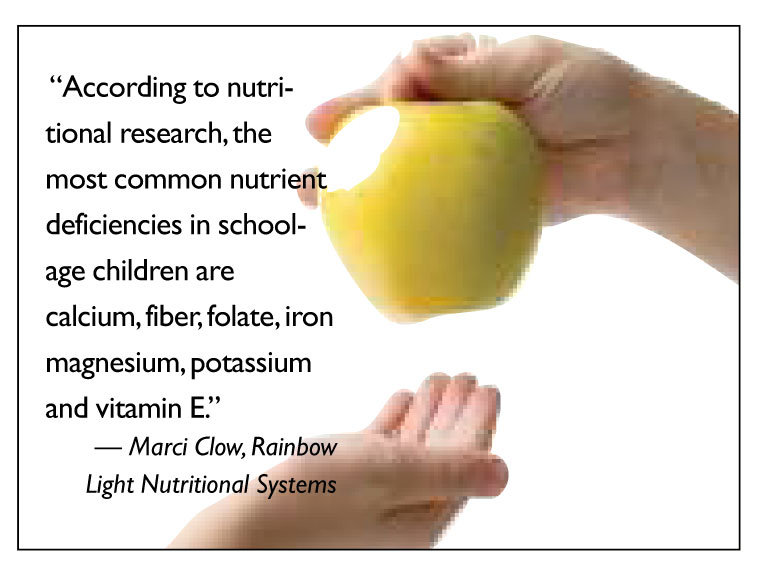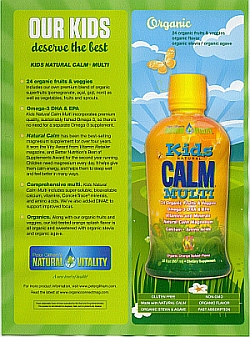If you were to ask a group of teens to wear a pedometer, how many would you guess are getting at least 30 minutes of physical activity per day? According to the National Health and Nutrition Examination Survey, just 8% (1)! In fact, nearly one in five teens is overweight (17.6%), as are children ages six through 11 (17%) (1). Also problematic are their rates of associated health problems like elevated cholesterol, blood pressure and blood sugar levels.
The situation is critical, and many families are looking to make lifestyle changes so their children don’t end up as part of these sad statistics. These efforts are positive steps in the right direction, and could be the start of great things to come. Said Stuart Tomc, CNHP, national educator for Nordic Naturals, Watsonville, CA, “As children get older and are able to make more choices on their own, a good foundation of healthy eating early can help ensure they are making wise decisions.”
These lifestyle changes are where natural stores fit in. With just a little creativity that both kids and parents will appreciate, your store can be a resource center for families looking to improve their health.
 1. Help Families Find a Nutritional Balance
1. Help Families Find a Nutritional Balance
One of the most basic things a store can do is to get parents to do some truthful self-analysis of their children’s nutrition. Says Keri Marshall, M.S., N.D., medical director at Gaia Herbs, Brevard, NC, “There are many nutrients that children are deficient in if they do not eat a balanced whole foods diet, including a minimal of five servings daily of fruits and vegetables. vitamins and minerals in general will be deficient if fruits and vegetables are absent from the diet or are limited in diversity.”
Marci Clow, R.D., senior director of product research at Rainbow Light Nutritional Systems, Santa Cruz, CA, offers some practical advice for determining whether kids’ diets get a passing grade for calorie content, though she notes that children’s metabolism and activity levels should be considered as well. According to the American Academy of Pediatrics, kids require 40 calories per inch of their height.
Retailers, why not post a wall chart with this information and invite parents to calculate how many calories their child needs? (Don’t forget to remind parents to discuss dietary changes with a pediatrician before embarking on a new diet.)
Some may be surprised to learn their children are consuming too few or too many calories per day. Says Nena Dockery, scientific and regulatory affairs manager of enzyme supplier National Enzyme Company, Forsyth, MO, “Some children will appear very healthy, but seemingly eat all the wrong foods and others will appear to eat healthy foods, but still may be prone to infections. And, most parents are far too busy to count the calories their children consume or force compliance to rigid dietary restrictions.”
Dockery offers some simple advice: try to include a source of protein, calcium and fruit/vegetable at each meal, keeping in mind that “lunch and dinner should include something green and/or yellow.” Plus, she adds, making snack time fun and healthy will help. “This will curb appetite and add an extra punch of nutrition into their diet,” she says. For more on creative snacks, see the tip on “Make your Store the Go-To Place for Family Meals.”
Another challenge of kids’ meals is conquering the lunchroom full of enticing trade possibilities, cafeteria junk food and vending machines. Though schools are making improvements in their meal offerings, a parent’s best bet is packing a healthy lunch and explaining to kids the benefits of the foods they eat. “Children who are eating healthy, whole foods will look and act healthier. Since food provides the energy for growth, if your child is growing normally, you know they are getting enough,” says Eileen Sheets, managing director, Bioforce USA, Ghent, NY.
Retailers can arm parents and kids with this kind of information in their stores to support healthy food choices— which may ensure return visits in the future.
 2. Fill Nutritional Voids
2. Fill Nutritional Voids
Once parents are critically looking at what their children are and are not eating, they will probably be interested in learning about supplementation options. In designing a section devoted to children’s supplements, you may want to consider “the multi and beyond.” While the majority of nutrition should come from dietary sources, many kids may need some extra supplementation.
“My thought is that supplements should be used for what their name suggests: to supplement nutrients into the diet to support optimal growth and healthy cognitive development, not as a replacement for the many other benefits received from food,” says Clow.
Multivitamins are a good base for most children, even for kids who are served nutritious meals. Parents can’t be absolutely sure their child ate those carrot sticks or apple wedges packed in their school lunch. And, are kids really eating all their broccoli at dinner? Above and beyond that, most children on a restricted diet (either because of picky eating, poor meal planning or a health condition) may be missing out on a host of important nutrients.
So again, stocking a variety of multivitamins in several delivery forms will likely appeal to children and parents. According to Lester Burks, CMO of Life Line Foods, Pikeville, TN, some forms, such as his company’s line, offer “a whole food complex, [in] an easily absorbable liquid form of key vitamins and minerals to supplement a healthy diet.” See sidebar, “Options for Multivitamins” for examples of some fun delivery forms on the market.
hen picking products, advise parents to look carefully at the nutritional panel keeping in mind that “the most common nutrient deficiencies in school-age children are calcium, fiber, folate, iron, magnesium, potassium and vitamin E,” says Clow. A good multi will also have all the basic vitamins and minerals a kid needs—like vitamin D.
Unfortunately, recent research indicates that many children aren’t getting enough of this important vitamin thanks to poor diets, indoor lifestyles or using sunscreen (since the vitamins are synthesized from sunlight). A 2009 report showed that 70% of kids aren’t getting enough vitamin D, and the researchers were especially concerned with how this could affect their health as children and as adults. “We were astounded at how common it was,” study author Michal Melamed, M.D., and assistant professor of medicine, epidemiology, and population health at the Albert Einstein College of Medicine, told CNN. “There is a lot of data that suggests adults with low vitamin-D levels are at risk for diabetes, high blood pressure, cardiovascular disease, and a lot of cancers, and if kids start out with low levels and never increase them, they may be putting themselves at risk for developing all of these diseases at a much earlier age” (2).
The study also noted that children with low vitamin D levels tend to have high blood pressure and lower levels of good cholesterol.
 About two years ago, medical associations started weighing in about the importance of vitamin D, with certain groups recommending that individuals take more vitamin D than was previously recommended. For instance, the American Academy of Pediatrics suggested that teens and children—including breastfed infants—get at least 400 IUs daily. Previous recommendations from 2003 were only 200 IUs.
About two years ago, medical associations started weighing in about the importance of vitamin D, with certain groups recommending that individuals take more vitamin D than was previously recommended. For instance, the American Academy of Pediatrics suggested that teens and children—including breastfed infants—get at least 400 IUs daily. Previous recommendations from 2003 were only 200 IUs.
Advises Jolie Root, education consultant at Carlson Laboratories (maker of kids’ products such as cod liver oil and Baby D-Drops), Arlington Heights, IL, “Parents would be well advised to have their children’s vitamin D level tested to be sure that their child is not deficient, since a vitamin D drop daily would correct the level easily.”
Of course, vitamin D is also known to help the body better absorb and use bone-building calcium, for which many children are deficient. The situation is also problematic for teens, especially girls. Studies indicate only 12% of girls and 32% of boys are getting the calcium they need (3). Bones develop quickly during the ages of 11 and 15, when they are also storing the calcium needed later in life. Since about half of all bone is formed during this time, it’s especially important to consume enough calcium (1,300 mg per day). Insufficient amounts may lead to osteoporosis later in life.
Also in the bone health arena is magnesium. According to Carolyn Dean, M.D., N.D. in The Magnesium Miracle, children may become magnesium deficient if they eat too many processed foods like hot dogs and deli meat and drink too many carbonated beverages. These products contain phosphates, she says, “which bind with magnesium to make insoluble magnesium, which is not absorbed by the body.” But, getting enough magnesium helps the body feel relaxed. “With proper amounts of magnesium, nature makes sufficient serotonin and you experience emotional balance,” Dean states (4).
 In addition, experts also suggest that children get enough omega-3s for optimal brain development and other health benefits. Kids don’t eat nearly as much fish as they should, and probably aren’t getting the DHA they need from the diet. According to Sheila Gautier, who works in scientific affairs at Martek Biosciences Corp., Columbia, MD, “In the recently released FAO/WHO Interim Report, the World Health Organization recognized the role of DHA as critical for brain and eye development in ages 0–24 months.” An interesting study covered in the March 2009 edition of WholeFoods indicated that premature girls fed a DHA-rich diet exhibited better mental development than those fed a low-DHA diet.
In addition, experts also suggest that children get enough omega-3s for optimal brain development and other health benefits. Kids don’t eat nearly as much fish as they should, and probably aren’t getting the DHA they need from the diet. According to Sheila Gautier, who works in scientific affairs at Martek Biosciences Corp., Columbia, MD, “In the recently released FAO/WHO Interim Report, the World Health Organization recognized the role of DHA as critical for brain and eye development in ages 0–24 months.” An interesting study covered in the March 2009 edition of WholeFoods indicated that premature girls fed a DHA-rich diet exhibited better mental development than those fed a low-DHA diet.
Omegas are important for all children and teens, as they are said to help with focus and development. Last year, a report found that autistic children experienced better speech, coordination, eye contact and digestion when given vitamin E and EPA/DHA supplements (see October 2009 issue of WholeFoods for more). And, researchers have linked Iq and cognitive function to DHA. In 2008, researchers found that preschoolers who were given algal DHA supplements had better vocabularies and listening comprehension than children who didn’t take the supplements (5).
Amy Marlow, MPH, RD, CDN, nutrition advisor for HappyBaby, New York, NY, maker of organic baby and toddler foods, notes that ALA sources of omegas are also good for children, since they need the fiber and ALA converts to DHA/EPA (for more on this conversion, see this month’s feature on omega-3s, page 36). Referencing her company’s HappyTot products, she states, “I recommend feeding young children fatty fish and other sources of omega-3 fats including foods fortified with DHA or the super-grain Salba.” Marlow explains that this branded supergrain is rich in the omega-3 fatty acid ALA and offers other nutrition, too: “Ounce for ounce, Salba also contains six times more calcium than milk, offering a power-packed nutrient necessary for healthy bones and teeth. The supergrain is also one of the richest sources of such antioxidants as vitamin C, which helps children fight infections and improves iron absorption.”
Deirdre Murray, assistant brand manager at beveri, Fitchburg, WI, adds that ALA-rich flaxseed is also a great way to introduce omega-3s into a child’s diet. These seeds can be used as a topping on yogurts or even in the breading of home-made chicken tenders. “We try to have consumers incorporate flaxseeds into their daily lives, rather than just as a supplement... Our key message is making healthy choices easy for people,” Murray states.
|
HERBAL SUPPLEMENTS: APPROPRIATE FOR CHILDREN? BY HENNA KATHIYA Herbal supplements are a growing trend with four out of 10 adults using complementary and alternative medicine (CAM) therapy (1). Adults are not the only people using such natural medicine. According to a national survey conducted by the U.S. Centers for Disease Control and Prevention, more than one in nine children and teens use herbal supplements or some other form of alternative medicine (2). However, the question remains: Are herbal supplements safe for children? Generally, there are many herbal supplements that are completely acceptable for children and teens to use. Dan Chapman, founder and CEO of Redd Remedies, maker of Children’s Sinus Support, says, “Many parents think that herbs have no proven safety record, but that statement just isn’t true for many herbal medicines. For example, ivy leaf extract and bromelain are plantbased medicines that have a proven track record of safety in children. This fact has been shown by both clinical research and historical use in populations.” David Winston, RH (AHG), president of Herbalist & Alchemist, Washington, NJ, agrees that herbal remedies are somewhat misunderstood. "The vast majority of the world still uses herbal medicine as a primary treatment modality. And for millennia, herbs have been the primary method of medicine throughout the entire world. So of course, hundreds of millions, perhaps billions of children have used herbs." For instance, children regularly consume herbs in the form of spices such as garlic, basil, cinnamon and thyme are herbs. "These are all herbs that are commonly consumed on a daily basis in substantial quantities--in every culture throughout the world. We know that they are safe. So, yes, herbs are appropriate for children," says Winston. But, it's important to note that every herbal supplement is not appropriate for children. "In Cherokee tradition, we divide herbs as to how they affect people into three categories: food, medicine and poison. The food herbs are the gentle herbs. These are herbs that are non-toxic; even in considerable amounts they are very unlikely to cause adverse effects, so those herbs are most appropriate for children," Winston explains. The are stronger-acting in the mecidine cateogry may be appropriate for children, "but you need knowledgeable guidance here," he says, adding that the third category is inappropriate for kids. Some popular kid-friendly herbs according to interviewees are chamomile, lemon balm, echinacea, stinging nettle and gotu kola (though parents should consult a pediatrician before trying them). Keri Marshall, M.S., N.D., medical director at Gaia Herbs, believes, “Herbal supplements are a safe and gentle way to address behavioral or mood disorders. While there have been more studies focused on herbs and adults for mood issues, side effects are generally rare in these studies, especially when compared to the side effects that many conventional pharmaceuticals have that treat mood and behavioral disorders.” Her company will launch a kids’ line this fall complete with mood-supporting products. Immune support is one main reason why parents turn to popular herbal supplements. According to Eileen Sheets, managing director at Bioforce USA (maker of the Echinaforce, Junior supplement), echinacea is especially good on this front, which she says has much research support. “Children on average get six to 10 colds of varying degrees a year, compared to the average cold incidence for adults, between two and five,” Sheets says. “Due to high level of interactivity in the classroom and in extracurricular activities, children tend to give their colds to their peers. Echinacea is safe when used as directed.” References 1. “CAM Use Stable In The United States, Says Survey,” WholeFoods Magazine, 32 (2), 8 (2009). 2. “About 1 in 9 U.S. Kids Use Alternative Medicine,” www.msnbc.msn.com/id/28159493, accessed August 2, 2010. |
According to Maday Labrador, director of scientific affairs at Enzymedica, Port Charlotte, NC, many children can benefit from an enzyme supplement—and it’s not only for those with digestive issues. “If a balanced diet plan is not followed then children are more likely to need support for growth and development,” she states, adding, “For example, cooked and processed foods are enzyme-less foods.”
When kids’ systems are enzyme deficient, a slew of digestive issues may occur such as food allergies, constipation, diarrhea and hear tburn. Plus, they may not be making the best use of the nutrients they are taking in. “Children can benefit from supplemental enzymes that enhance digestion in order to transport those important nutrients into cells for the body to use. Enzyme supplements can be extremely useful not only to prevent digestive issues, but also to ensure absorption of nutrients from foods,” states Labrador. There are several enzyme supplements on the market geared for children such as Kids Digest and Digest Spectrum from Enzymedica.
3. Support Attention Disorders
Another area that needs more consumer education is the link between certain chemicals (like artificial food dyes, pesticides and BPA) and negative health outcomes in children. Over the past two to three years, evidence has surfaced for why children should not be exposed to these chemicals, but yet there’s been very little public outcry against them. States Marlow, “I think that if more parents knew about the risks, perhaps they would take action.”
Part of the problem could be that these chemicals are so ubiquitous that parents don’t see them as problematic. “Misinformation and miseducation regarding these chemicals and their dangers has lead to a complacent mediocrity with many consumers,” believes Summer McFarland, who is in sales and marketing at Maxam Nutraceutics, Hood River, OR. “This information is not taught, but is available if you look for it.”
Three areas of education that retailers can focus on are pesticides, food dyes and BPA. This May, a monumental study found that children were more likely to have attention deficit and hyperactivity disorder if they were exposed to the pesticide organophosphate. Kids with the highest levels of exposure were 93% more likely to have ADHD. Even scarier was that small levels of exposure were associated with a high risk, too. “This is not a small effect,” study co-author Maryse Bouchard told The Washington Post, “and it is certainly cause for concern” (6).
Researchers, such as those at the Environmental Protection Agency (EPA), suspect that this pesticide may affect how the nervous system functions. Children may be especially prone to this because of their small body size.
Sharing this information with parents may help them realize how important it is to consider providing their families with organic foods. “The use of these hazardous items is so pervasive that many people are not even aware that they are consuming them from so many sources,” says Dockery.
 Next is the frustrating situation in the food dyes arena. Studies indicate that certain artificial food dyes are linked to learning and behavioral problems in children. A 2007 study showed that kids exposed to certain artificial red and yellow food dyes were more hyperactive than other children (7). This research prompted U.K. regulators to reconsider which dyes it would allow for sale, but the U.S. Food and Drug Administration has not yet gone down that road.
Next is the frustrating situation in the food dyes arena. Studies indicate that certain artificial food dyes are linked to learning and behavioral problems in children. A 2007 study showed that kids exposed to certain artificial red and yellow food dyes were more hyperactive than other children (7). This research prompted U.K. regulators to reconsider which dyes it would allow for sale, but the U.S. Food and Drug Administration has not yet gone down that road.
Getting parents and kids (and, in turn, commercial food companies) to stop preferring artificially dyed foods will be tough. Says Dockery, “Americans seem to love their brightly colored foods, and once again, don’t think about the source of the beautiful, yet unnatural colors. unfortunately, artificial colors are probably here to stay.” But, education can play an important role here: “We always have a choice. We don’t have to buy foods that have been colored,” she states.
Marshall notes that we also need more research into the topic before regulators will force mainstream food companies to change their ways. “What is most interesting to me is that many people who make policy decisions regarding the above mentioned, personally eat organic food and use stainless steel water bottles, yet they do not implement change on a policy level,” she says. “Part of the problem is that policy change is dictated by hard science and until there are substantiated studies that definitively prove that these things are bad for us, we will not be forced to make policy change.”
Last is the issue of bisphenol-A (BPA), a chemical used to make some hard plastics and the lining of aluminum cans. When heated, this chemical can leach into foods and may be an endocrine disrupter. In a 2008 study done on non-human primates, researchers at yale university found that BPA may interfere with memory and mood, and small-animal studies indicate it may even cause cancer. Thus, the U.S. Food and Drug Administration issued a statement earlier this year expressing “some concern” about its use in products intended for infants and children (8). And, the EPA announced in March that it will assess the ecological effects of this chemical.
Retailers can be sure parents are aware of this research into BPA and offer products (like baby bottles and canteens) that are free of this chemical. States Burks, “Parents shouldn’t have to worry about these harmful chemicals in their children’s food, and they should be able to trust that the companies that produce health supplements for children would be especially concerned.”
 Nutrition and behavior. Since the aforementioned chemicals may create or exacerbate attention and behavior issues, it warrants mentioning what natural options parents have for such issues (such as ADHD/ADD and/or autism).
Nutrition and behavior. Since the aforementioned chemicals may create or exacerbate attention and behavior issues, it warrants mentioning what natural options parents have for such issues (such as ADHD/ADD and/or autism).
Let’s talk first about diet. Attention issues can be fueled even more by the wrong foods like sugar and caffeine. And, as previously noted, avoiding artificial colors, artificial preservatives and chemical pesticides may help, too.
According to David Winston, RH (AHG), president of Herbalist & Alchemist, Washington, NJ, "ADD/ADHD can be treated very effectively by dietary changes, some nutritional supplements (Pycnogenol for example) and herbal medicines." He adds, "While there may be a link between artificial food dyes and hyperactivity in children, there is also a link to food sensitivities such as wheat, dairy, sugar and aspartame, which is a neurotoxin."
Winston also makes the point that behavioral and lifestyle changes can help. "For example, children with ADHD/ADD often have information processing issues," he explains. "Breaking down tasks or projects into small, easily achievable components to foster a sense of accomplishment and completion is useful. Some form of cognitive therapy can be beneficial as well."
On the autism side, much anecdotal evidence supports the use of a gluten-free and casein-free (GFCF) diet. Some believe this diet is preferred by so many parents of autistic children because of poor digestion, which is common in these kids. A recent survey of parents with autistic children conducted by Enzymedica and the Enzyme Research Group found, “a statistically significant 80% of autistic children experience digestive disturbances related to certain types of food, with dairy topping the list. 57% said dairy is the culprit, and wheat was second in line with 43%.”
If gluten and casein are not completely broken dow, they may enter the bloodstream and affect neurotransmission. The end-behaviors are found in children with autism (9). A GFCF diet may not work in all children but many experts have found that “sensitivities and food intolerance plague children on the sutistic spectrum,” says Labrador. This may be due to an enzyme deficiency.
Adds Labrador, “If digestion is inadequate, production of neurotrasmitters involved in brain function is insufficient. In some cases, enzyme supplementation can be crucial.”
Due to the digestive problems in children with these disorders, McFarland of Maxam Nutraceutics, believes supporting healthy digestive flora is important. “Many children…find great improvement by addressing yeast overgrowth in the intestines and replenishing good bacteria, doing a gentle detox for heavy metals, parasites and mycotoxins released from yeast as they die off, and supporting the adrenals and immune system,” she states, noting that her company’s BioGuard is designed for this purpose. In addition, probiotics can help.
While the causes of disorders like ADD/ADHD and autism are unknown, and supplements are by no means a cure, there are products that support attention and focus. As previously mentioned, magnesium can play a role in helping maintain a calm, focused mental state, as do certain B-vitamins like B6. This vitamin helps boost levels of pyridoxal-5-phosphate (PLP), which is needed for dopamine production. Dopamine, of course, is a neurotransmitter that affects many aspects of brain function. For that matter, a good multivitamin is imperative since “a deficiency of any single nutrient can lead to impaired mental function,” according to Michael T. Murray, N.D. of Natural Factors, Everett, WA, in an essay (10).
Gamma-aminobutyric acid (GABA) is another calming agent that is said to be helpful for those experiencing stress and anxiety, but new research indicates certain children may benefit from GABA supplements, too. According to Murray, “Recently, studies have indicated that enhancing GABA activity may be beneficial in improving mental performance in children and may also be helpful in ADD” (11).
Murray cited a study from Kyorin university Medical School in which 60 sixth graders were either given a branded GABA supplement (PharmaGABA from Natural Factors) or a placebo. Then, they took a math test and were evaluated for stress. “The results were quite dramatic. The average number of questions answered by the PharmaGABA group was 20% higher than the placebo group and the number answered correctly also increased by 20%,” Murray stated. “These results indicate that PharmaGABA helped the kids not only think faster, but also get more answers right.”
Omegas are also important for this proper focus and attention. “Research on supplements with omega-3 fatty acids (fish oil) and omega-6 fatty acids and Pycnogenol have shown improvement with these conditions and some children may benefit from supplementation with nutrients to improve absorption and heal their intestinal lining,” says Tomc of Nordic Naturals, whose company makes a variety of omega-3 supplements for kids including Baby’s DHA, Omega-3 Effervescent, Nordic Omega-3 Gummies, Nordic Omega-3 Fishies and more.
Root points out why omega supplementation is so important: “Although the long chain fatty acids EPA and DHA show potential promise for treatment of autistic children, results of trials have been inconsistent; however, research has shown that levels of DHA were very low in autistic children.”
She also raises the importance of having an appropriate balance of omegas in the body, which includes GLA from evening primrose oil. In a trial of 117 children with learning challenges, kids who took an omega supplement (558 mg of EPA and 174 mg of DHA from fish oil plus 60 mg of GLA from evening primrose oil) experienced benefits after three months (12). Says Root, “The behaviors that improved included opposition, cognitive problems and hyperactivity. Reading and spelling advances were noted as well.”
According to Marshall, some herbal remedies are being studied to improve behavior, focus, anxiety and other mood disorders in children. Winston agrees on this point, noting that some herbs are calming (but not sedatives) such as Fresh Oat. "It is the herb that is used for people who have lost their emotional foundation or emotional balance and have become emotionally labile," he says, adding that hawthorn (solid extract form) is very beneficial, too. Also calming are "Lemon Balm, Linden flower and Chamomile, all of which can be taken as a tea, tincture or glycerite. Herbs such as Skullcap and Bacopa are also nervines and very appropriate for children with ADD/ADHD."
Other appropriate herbs include those that increase cerebral circulation (nootropics), according to Winston, like ginkgo, gotu kola, bacopa, rosemary, lemon balm and lavender.
See sidebar, “Herbal Supplements: Appropriate For Children?” for more information.
4. Make Your Store the Go-To Place for Family Meals
Consider your store a possible hot spot for fast meals that fit the needs of busy families. This doesn’t necessarily mean having an elaborate prepared foods section. Even if you have a small grocery section, you can send the message that your store is a smarter, healthier time saver than a fast-food drive-through.
The main thing to keep in mind for family snacks and meals is speed and ease. In addition to stocking prepackaged foods manufactured for children, some basic staples can be transformed into fun, kid-friendly foods with a little creativity.
According to Clow, this kind of fun experience with healthy foods is key for getting children to choose nutritious foods throughout life. “Most children really enjoy ‘helping’ in the kitchen. I’ve found that this really makes my kids excited about eating because they can exert control and eat whatever they made,” she states.
Burks agrees noting, when parents use fun recipes, “it gets kids eating more nutrient rich fruits, vegetables and grains, and involves them in the process of making better choices.”
Savvy retailers can use some of the following ideas from interviewees to make flyers and shelf-talkers with simple recipes. They’re bound to make kids happy and parents look to you as a valuable nutritional resource:
• Banana Caterpillars: Layer sliced banana and peanut butter (or nut butter) in a log formation to create a caterpillar, Dockery suggests. use raisins for eyes.
• Kiddie “Fondu”: “Toddlers and preschoolers like to dip, so an all-finger-food meal can be fun,” suggests Marlow. Cut raw or cooked veggies and whole grain bread into strips or small chunks. Serve with hummus, vegetable puree or a yogurt-based creamy dip for dunking.
• Fruitie Cookies: Cut fruits like apples, pears and melons into quarter-inch thick rounds. use yogurt for “icing” and crushed raw nuts as “sprinkles.”
• Taco Night: Fill hal f a wheat tortilla with organic cheese, green peppers and onions. Fold in half and heat in a toaster oven or pan.
• Sweet Potato Fries: Peel a sweet potato and cut into sticks. Toss with olive oil and bake until slightly crispy.
Be sure not only to point out the ease and speed with which these foods can be made, but also their nutritional value and the fact that they are heavy on whole foods. “Balance is the key,” says Craig Klein and Michael Schwartz of Michael’s Naturopathic Programs, San Antonio, TX. They emphasize that a kids’ meal should combine complex carbohydrates, healthy fats, fiber and lean protein. “This means whole grains, veggies, beans, fruits, nuts and seeds,” they say. “Expose the child not only to different foods, but various ways that any given food can be prepared. Finding options within these areas serves as a basis from which meals and snacks can be created.”
Don’t forget the pre-packaged snacks, too, like natural fruit leathers, string cheese, whole-grain cracker snack packs, squeezepacks of nut butter and other items. These portable options can also help with calorie counting. “Portion control is an important topic these days. With so many children overweight or obese, how much one eats is critical,” say Klein and Schwartz.
For more great kid-friendly food ideas, click here.
|
Options for Multivitamins The following are some of the many options available for children’s multivitamins that come in fun delivery forms (the expanded version appears online): * Animal Parade chewable tablets and liquids (various flavors) * Carlson for Kids Chewable Vitamin C, Calcium and other products from Carlson Labs * Liquid Dolphin Pals, Maxi-Baby Care Liquid and Tall Tree Child Multi-Vit Min Complex from Country Life * Multivitamin+D Mixed Berry Fruit Chews from Dr Sears Family Approved * Emergen-C Kids’ Effervescent Multi * Yummi Bears Organic Multivitamins from Hero Nutritionals * KidBear Kids Multi chewable tablets (and Yum Yum D3), Jarrow Formulas * Liquid Supplements like Children’s Complete, Added Attention and Children’s ACF from LifeLine Foods/Buried Treasure * Pedia Vites liquid and Children’s Chewables from Michael’s Homeopathy as well as multis for teens and preteens * Nordic Berries from Nordic Naturals * Rhino Chewy Vites from Nutrition Now * Gummy Bear Essentials, Gummy Power Sours, NutriStart Multivitamin Powder, Nutristars Multivitamin and Kids One Multistar chewable tablets from Rainbow Light plus tableted multis for children and teens, Gummy Omegalicious, Vitamin C Slices and more * Kids Calm Multi from Peter Gillham Natural Vitality * Kangavites Complete chewable vitamins from Solgar Vitamin and Herb * Kids Multi Liquid and Complete Children’s Chewable from Trace Minerals |
Talk to Kids Directly
Possibly one of the most important things you can do in your store to encourage good nutrition is to talk to children directly about nutrition. Consider fun ways to get children to know and love nutritional products such as:
• Host a parent–child scavenger hunt. use clues to lead to children around your store, and have them answer nutrition-related questions (e.g., If you take XX multivitamin, how much vitamin C will you get per serving?)
• Hold a healthy kid-friendly recipe contest.
• Offer a parent/child “cooking class” using simple recipes like those mentioned.
• Sponsor a 5-K walk for children, providing healthy refreshments to participants.
• Offer to send your store’s nutrition expert to give a talk about healthy eating to kids’ groups like a 4H club or boy/girl scout troops.
• Hold a photography contest for children in categories like nature or fruits and veggies. Post the best ones on your Web site. WF
References
1. National Health and Nutrition Examination Survey (NHANES) 2003–2006 and 2007–2008, http://win.niddk.nih.gov/statistics/, accessed August 2, 2010.
2. D. Mann, Vitamin D Deficiency Common in U.S. Children,” Aug. 3, 2009, www.cnn.com/2009/HEALTH/08/03/vitamin.d.children/index.html, accessed August 1, 2010.
3. Center for Young Women’s Health, Children’s Hospital Boston, www.youngwomenshealth.org/calciuminfo.html, accessed August 1, 2010.
4. C. Dean, The Magnesium Miracle (Ballatine Books, New York NY, 2007).
5. Ryan, A. S. and E. B. Nelson (2008). “Assessing the effect of docosahexaenoic acid on cognitive functions in healthy, preschool children: a randomized, placebo-controlled, double-blind study.” Clin Pediatr (Phila) 47(4): 355-62.
6. C. Butler, Hidden hazards in fruits and veggies,” June 1, 2010, www.washingtonpost.com/wp-dyn/content/article/2010/05/31/AR2010053101914.html, accessed August 1, 2010.
7. D. McCann et al., “Food additives and Hyperactive Behaviour in 3-Year-Old and 8/9-Year-Old Children in The Community: A Randomised, Double-Blinded, Placebo-Controlled Trial,” The Lancet, 370 (9598), 1560–1567 (2007).
8. FDA Declares ‘Some Concern’ for BPA Ingestion in Infants and Children,” WholeFoods Magazine 33 (3), 11(2010).
9. “Autism and ADHDL The Nutrition–Behavior Link,” WholeFoods Magazine 32 (10), 22–28 (2010).
10. M.T. Murray, “Nutritional Support for Improved Attention and Focus.”
11. M.T. Murray, “Natural GABA for Smarter Kids?”
12. A.J. Richardson and P. Montgomery, “The Oxford-Durham Study: A Randomized, Controlled Trial of Dietary Supplementation With Fatty Acids in Children With Developmental Coordination Disorder,” Pediatrics 115 (5), 1360–1366 (2005).
If your store has reached out to children in a unique way, tell us about it. WholeFoods would love to share your success stories on our Web site. E-mail Editor Kaylynn Chiarello-Ebner at kaylynnebner@wfcinc.com.
Published in WholeFoods Magazine, September 2010











